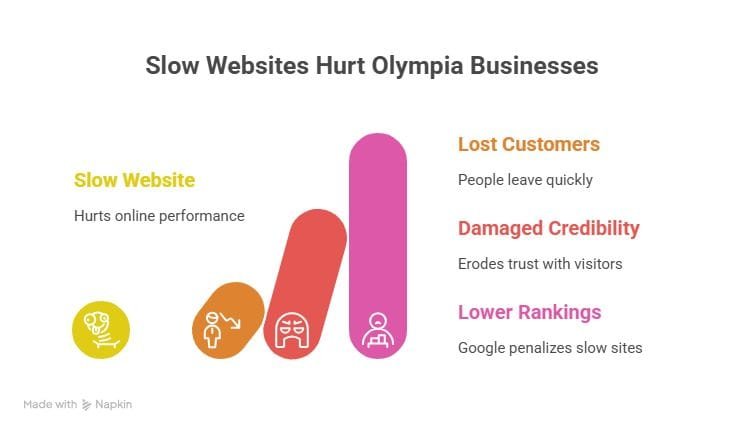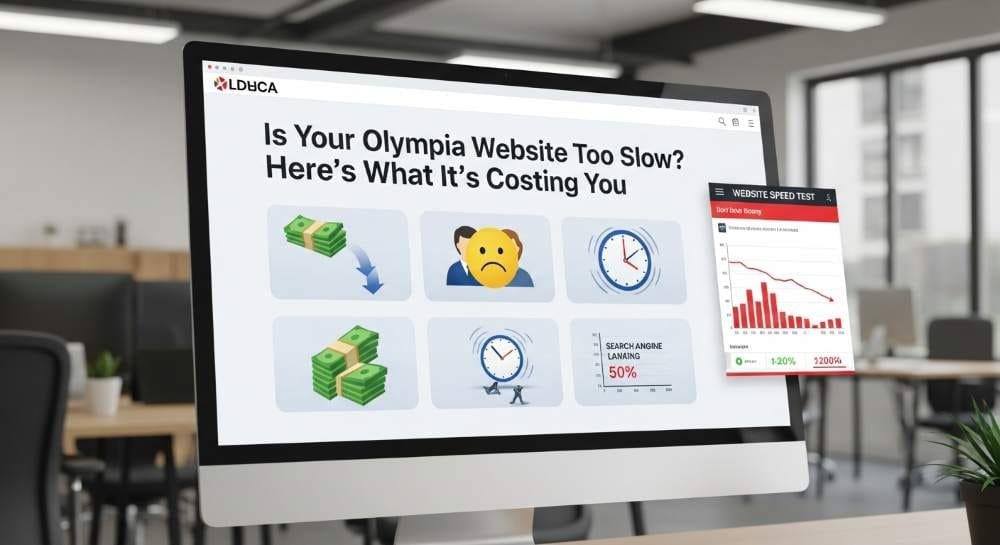What if one slow second could cost you half your visitors?
Here’s a stat to startle you: when a mobile page takes more than 3 seconds to load, over 50 % of visitors will abandon it.
In other words, your beautifully designed site means nothing if it doesn’t load fast, because people won’t wait.
If you’re a business in Olympia, WA, your website isn’t just a billboard, it’s often the first handshake a potential customer has with your brand. That first handshake better be quick, or the visitor moves on before even giving you a chance.
This post explains why speed is now mission critical for Olympia web development, what’s causing slowdowns, what real businesses in Thurston County lose when their sites lag, and practical fixes you can implement without blowing your entire budget.
The Urgent Problem: Slow = Invisible + Untrusted
Why speed now outranks mere “looks”
- Google considers page speed and Core Web Vitals as real ranking signals.
- Visitors have short attention spans. If your site loads sluggishly, prospects bounce before you can persuade them.
- Across industries, every additional second of load time cuts conversion rates by 2 %–7 % or more.
- Slower sites often correlate with poor mobile experience, and more than half of web traffic today comes via mobile.
So in Olympia’s competitive local services space (contractors, legal, clinics, retail, hospitality), your site needs to compete not just on content and visuals, but on performance.
What Olympia businesses are losing
Consider this scenario: a local coffee shop in Tumwater redesigns their menu and hours page but neglects performance. A visitor searches “espresso near me Olympia” on their phone, taps your site, but it takes 4–5 seconds to load. Many won’t wait. Lost sale. Lost loyalty. Lost chance to stand out against the café down the street whose site loads in 1–2 seconds.
Multiply that across dozens of daily visitors, and it becomes a measurable leak in your marketing funnel.

Why Websites Slow Down: The Usual Culprits
Understanding the root causes helps you fix (or ask your web dev to fix) wisely. These are common performance killers:
Heavy images and media
Images often account for the bulk of page weight. Using unoptimized formats like large JPEGs or PNGs slows everything down. Newer formats (e.g. WEBP, AVIF) can cut image load size by 15 %–21 %.
Bloated JavaScript and CSS
Many pages pull in libraries and scripts that are not fully used (“dead code”). Some studies suggest 30 % or more of JS in pages is unused.
Parsing, compiling, executing these scripts adds delays.
Excessive third-party scripts
Widgets, analytics, chat plugins, ads, each may load from external servers, adding latency or blocking render.
No caching, poor browser rules
Failing to leverage HTTP caching or browser caching forces repeat downloads of assets with each visit.
Slow hosting or geographic latency
If your server is far from your target audience, or on a slow shared setup, data takes longer to travel. Olympia visitors will feel that.
No lazy loading or deferring
Loading all images and scripts upfront (rather than only when needed or on scroll) delays the first usable render.
Real-World Consequences (Olympia-Focused)
Fewer conversions, fewer leads
A local landscaping business might get 200 visitors a week. If slow speed reduces conversion by 3 %, that’s 6 fewer customers just because the site lagged.
Reputation damage
Slow performance feels unprofessional. People equate sluggishness with lack of care, even if your actual service is excellent.
SEO decline
Google’s algorithms reward fast, responsive websites. Falling behind in speed hurts your discoverability in “Olympia web development,” “Olympia businesses,” or other local keyword searches.
Competitive disadvantage
If your competitor in Olympia invests in Olympia web development optimized for performance, they win the first impression, and possibly the customer.
How to Fix It (Practical, Budget-Aware Tips)
Here are real steps you can take, or ask your Olympia web developer to implement:
1. Audit performance
Use tools like Google PageSpeed Insights or Lighthouse. They’ll tell you exactly what’s slowing your site (images, JS, unused CSS).
Look for metrics like LCP (Largest Contentful Paint), FID (First Input Delay), CLS (Cumulative Layout Shift).
2. Optimize images
- Convert to WebP/AVIF where possible
- Resize large images before uploading
- Use compression (lossy or lossless)
- Use responsive images (
srcset) - Lazy load below-the-fold images
3. Trim JavaScript and CSS
- Remove unused code
- Split code and lazy load nonessential scripts
- Minify and compress JS/CSS
- Use tree shaking tools
4. Use caching and CDN
- Configure browser caching so returning visitors reuse resources
- Use a Content Delivery Network (CDN) so files load from servers close to your visitor
- Use server-level caching (e.g. full-page cache, object caching)
5. Defer noncritical scripts
- Load essential scripts first
- Defer or async load chat widgets, analytics, ads
- Inline critical CSS for above-the-fold content
6. Choose good hosting
If your Olympia-targeted site is on a shared server far away, consider upgrading to faster, geographically optimized hosting or managed WordPress / static-site server setup.
7. Monitor continuously
Performance isn’t a one-and-done fix. As you add content or features, new bottlenecks may arise. Use Real User Monitoring (RUM) to track real visitor experiences.
Why This Strategy Aligns With Hyper Effects’ Olympia Web Development Approach
At Hyper Effects, we believe web development should be practical, data-driven, and resource-conscious, not flashy or wasteful.
We help Olympia businesses focus on what matters most: building fast, responsive, and sales-ready websites that perform beautifully on every device.
Our process starts by tackling low-hanging fruit like image compression, caching, and script optimization before diving into deeper performance layers. This ensures measurable improvements without unnecessary redesign costs.
You don’t have to rebuild your entire site to see results. With Hyper Effects, every enhancement, whether it’s faster loading, smoother navigation, or improved Core Web Vitals, directly translates to better conversions and customer trust.
When you work with our Olympia web development team, you’re not just getting a website that looks great. You’re getting one engineered to load fast, rank higher, and convert better. We build with speed and scalability baked in from day one, so your site stays future-ready as your business grows.
At Hyper Effects, our philosophy is simple: a slow site costs you money, a fast site makes you money. That’s why performance isn’t an afterthought for us; it’s part of every build, every update, and every strategy we create for Olympia businesses.
Future Outlook & Local Stories
As more Olympia businesses move online, from Olympia’s Capitol District shops to Tumwater restaurants, the baseline for “good” keeps rising. Expect:
- Search engine algorithms will tighten speed thresholds
- Mobile traffic will dominate even more (wearables, voice, IoT)
- Clients will expect near-instant access to event schedules, menus, booking
I spoke with a friend who runs a boutique in downtown Olympia. They recently revamped their site, but their developer forgot lazy-loading images. When they saw that some pages loaded sluggishly on phones, they lost calls from customers trying to check hours. After an image and caching patrol, pages dropped from 8 s to under 2 s and call volume jumped back.
That kind of turnaround doesn’t require a six-figure budget, just the right prioritization.
Frequently Asked Questions
Q: Isn’t web design more about visual impact than speed?
A: Visuals are vital, but if your design kills performance, prospects never see them. Performance and aesthetics go hand in hand in real Olympia web development.
Q: How much does speed optimization cost me in Olympia?
A: It varies. Some fixes are free (image compression, caching). More advanced ones (code refactoring, better hosting) require investment, but the ROI in increased leads and conversions often pays for it.
Q: How fast should an Olympia business website be?
A: Aim for under 2–3 seconds for first meaningful paint, with scores in the green zone for Core Web Vitals metrics.
If you run a local Olympia business, check your site speed right now. Run PageSpeed Insights. Share your results in the comments. Want a free mini-audit or help choosing an Olympia web development partner who cares about performance? Drop me a message, let’s make Olympia sites fast, effective, and winning.
Sources
- sitebuilderreport.com – Website Speed Statistics 2025
- webfx.com – Site Speed and Conversion Data
- arxiv.org – Image Compression and Format Efficiency Study
- arxiv.org – JavaScript Usage Analysis

